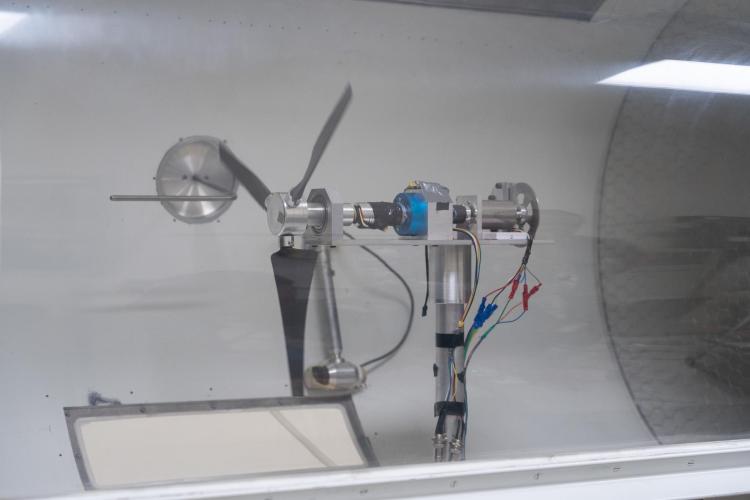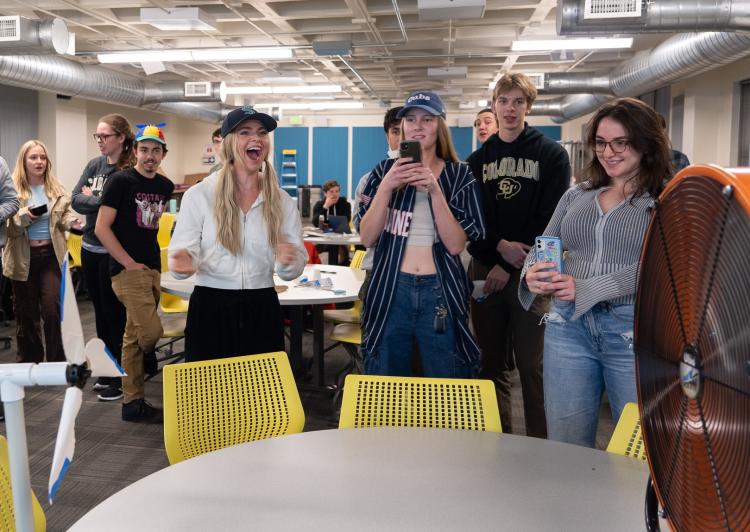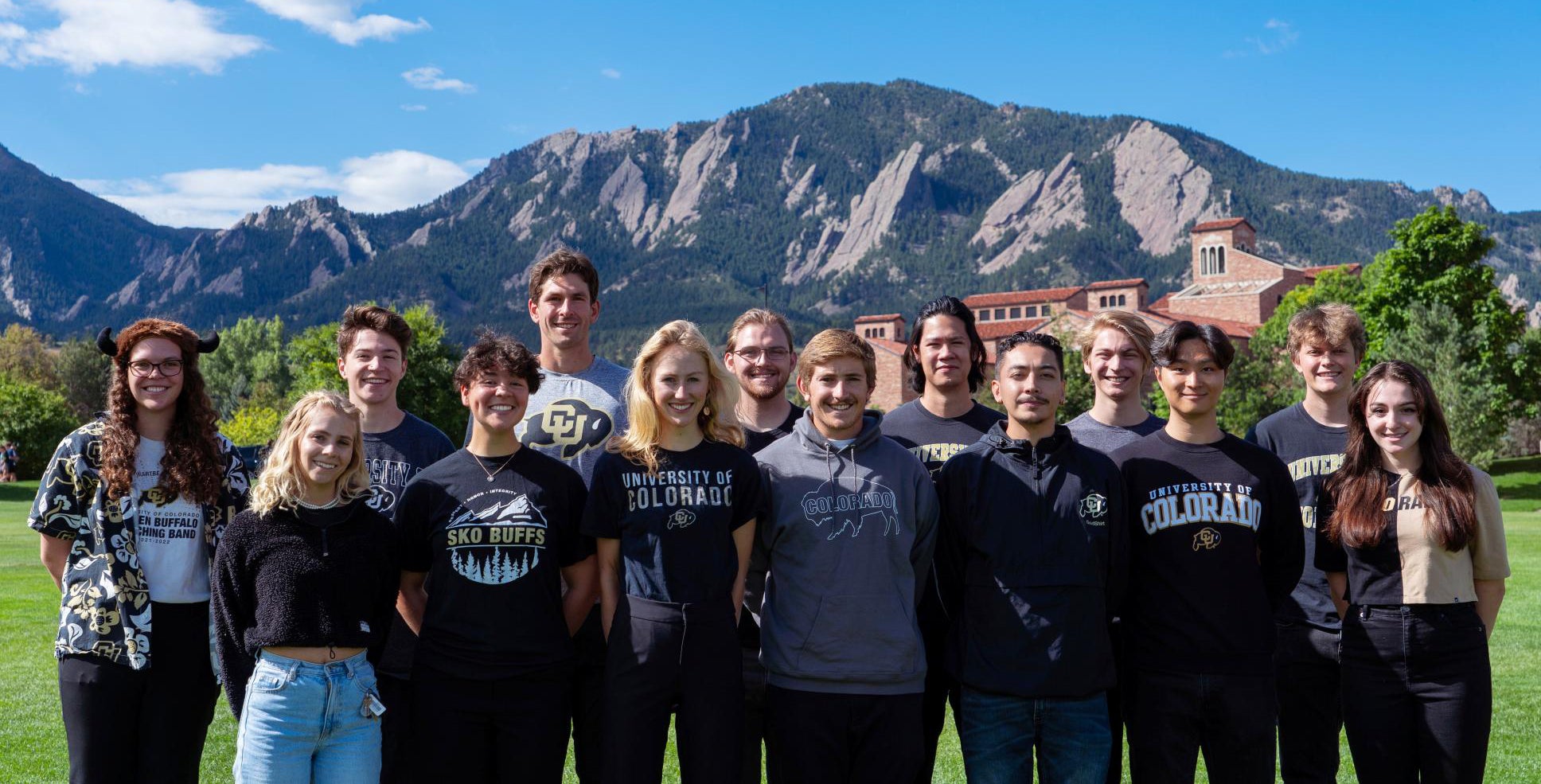Congratulations to the CU Boulder Wind Team for their second place finish in the national competition at the American Clean Power Association's CLEANPOWER Conference in May 2024 announced by the U.S. Department of Energy.
The CU Boulder Wind Team is harnessing their passion for renewable energy in the fight against climate change.
The team of 16 was selected as one of 12 winning universities for Phase Two of the 2024 U.S. Department of Energy Collegiate Wind Competition (CWC). They will put their wind turbine design to the final test when they present at the American Clean Power Association’s CLEANPOWER Conference and Exhibition on May 6-9 in Minneapolis.
The annual Collegiate Wind Competition aims to prepare college students for careers in the wind energy workforce through wind turbine design, project development and K-12 outreach experiences.
Harnessing wind for a carbon-free future

The CU Wind Team tests their prototype at the University Corporation for Atmospheric Research in Boulder, Colorado.
Wind energy — now the largest source of renewable power in the United States — will help support goals to reach net-zero carbon emissions by 2050. In Colorado, wind energy capacity and generation is the leading source of renewable power, making up 28% of the state’s electric grid, according to the U.S. Energy Information Administration.
“Wind energy doesn’t release carbon emissions and is essential for our total energy portfolio,” said Daniel Sherry, a senior in environmental engineering who hopes to work in the renewable energy industry after he completes his bachelor’s-accelerated master’s program.
“Being part of this competition pushes us to see how we can solve climate change in the best way possible,” said Sherry.
In CWC 2024, the focus is on offshore wind energy and examining how offshore wind plays a role in a diverse power system. Offshore wind energy is set to become a focus of the U.S. wind industry in the coming years. Industry, academia and government agencies are collaborating to address challenges unique to offshore wind, like withstanding hurricanes and assessing environmental impacts on shorelines.
“Renewables are inherently intermittent,” said senior electrical engineering major Stewart Rojec, “so it’s important for energy stability to be able to generate it in lots of different ways.”
The team leverages the power of wind energy in building a more renewable-focused future, as well as what makes renewable energy unique.
“Wind turbines complement solar panels, since they can generate electricity at night and on cloudy days when the sun isn’t shining. Wind turbines can be installed on land and at sea, meaning a completely green grid is more accessible to places with varying geography,” said Rojec.
As part of the competition, the CU Wind Team connected with wind energy experts at the National Renewable Energy Laboratory in Boulder and spoke to leading industry professionals at Siemens Gamesa, a global renewable energy company leading offshore wind energy production.
Engineering connections across fields
 The CU Wind Team is part of the Rady Department of Mechanical Engineering's senior design course, a capstone experience allowing students to apply technical knowledge they gained with real-world scientific challenges. This project and team are supported by grant funding secured by mechanical engineering faculty, that provided their team's mentor, fabrication and other essential resources.
The CU Wind Team is part of the Rady Department of Mechanical Engineering's senior design course, a capstone experience allowing students to apply technical knowledge they gained with real-world scientific challenges. This project and team are supported by grant funding secured by mechanical engineering faculty, that provided their team's mentor, fabrication and other essential resources.
This year brings together a multidisciplinary team across different engineering backgrounds — mechanical, environmental and electrical — drawing on collective knowledge that has proven to be an important ingredient for success.
“Our team members bring expertise in areas such as construction, environmental policy, aerospace, electrical and renewable energy,” said team Project Manager Elyse DeDarros who is a senior in mechanical engineering. “The team has worked so well together in all aspects of the competition.”
As part of Phase 2 for the CWC, the CU Wind Team completed the team’s turbine prototype for testing and a preliminary design report for a hypothetical offshore wind farm site.
Culminating at the final in-person competition in May, the team will test their wind turbine prototype designs and present their wind farm site designs.
Inspiring future scientists of tomorrow
On top of the design competition component, the team is helping to inspire the next generation of scientists through K-12 outreach activities in the Boulder and Denver areas.
This year, the Wind Team participated in Stem-A-Thon at the Superior Community Center in Superior, Colorado and hosted KidWind events at Ellis Elementary School in Denver teaching students about wind energy and engineering.
They also partnered with CU Boulder’s Mortenson Center in Global Engineering & Resilience first-year engineering projects class to host a KidWind event, where elementary school students designed and tested wind turbine blades.
“It’s really cool to see children’s innovation, and sometimes they do better than college students because they just do what feels right to them,” said DeBarros. “I’m amazed to see how interested they are in wind turbines, and it’s really neat to see the impact we’re having on younger generations.”
Regardless of the final result of the competition, DeBarros said, “our team agreed at the beginning of the year that we wanted to create a project we’re proud of, and we’re excited to see all of our hard work come together.”
As all teammates are graduating this spring semester, they’ll be jetting back right after the competition to participate in commencement ceremonies.
“To see a project start from scratch and see it through every stage with all my excellent teammates,” said Rojec, “especially when this is important to us and to the energy future is super rewarding.”
Image Photos: CU Wind Team partnered with a first-year engineering projects class to host a KidWind event where students designed and tested wind turbine blades.

